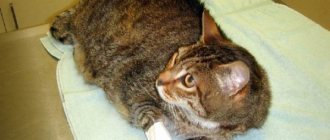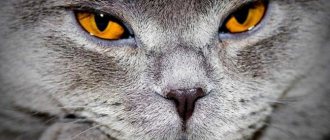May 14, 2020
One of the common reasons for pet owners to visit a veterinarian is when their pet falls from a window or from the balcony of their home.
The reason why cats fall from heights so often can be attributed to several factors. The first and perhaps most important is the carelessness of cat owners and misconceptions about feline behavior in general. Many people transfer their way of thinking to their pets and believe that they are fully aware of the dangers of certain actions and their possible consequences, so they cannot jump down from a window or simply fall. The idea of cats' agility does them a disservice because often their owners think that a pet simply cannot fall by tripping or miscalculating the height. In addition, the belief that cats always land on four paws lulls the vigilance of people who believe that even if the animal loses its balance, it will still land safely and remain unharmed.
Indeed, repeated experiments have revealed the reflexive ability of cats to take the desired position in the air to land on four paws, but this ability does not always save them from injury when falling. Not all cats are able to correctly orient their bodies in flight: kittens have not yet developed the appropriate reflexes; Severely obese cats are not very maneuverable in the air.
In addition, there are individual characteristics - not all animals have reflexes that work as they should. If a cat falls by accident, then it may simply not have time to orient itself and turn around in flight, and if it falls from a great height, the force of the impact will be enormous, and, regardless of what part of the body the animal lands on, it will receive serious injuries.
Symptoms of a cat falling from a height
Fractures and bruises
A bone fracture is associated with a complete or partial violation of its integrity. The main symptoms include pain, bone mobility, and dysfunction of the injured body part. The pain, very severe at the time of injury, becomes dull over time and may disappear when the animal is motionless.
The most striking manifestation of a fracture will be impaired mobility of the affected part of the body or limb: the cat will not be able to lean on the injured paw or chew food with the help of a broken jaw. The exception would be cases where a complete fracture has not occurred, but only a crack or other minor damage to the bone: in such a situation, the animal may not show any discomfort.
In the area of the fracture, the contours, size and shape of the broken bone may change, and even shortening of the limb may be observed. Such deformities can also occur with bruises, so it is important to fully examine the cat.
The main signs of a bruise will be pain, swelling, bruising and disruption of the functioning of the corresponding organ. Immediately after a bruise, dark purple bruises appear on the skin, resulting from ruptures of small vessels. Subsequently, the color of the damaged area will change to green, brown, and then yellow. Due to the release of blood and lymph from ruptured vessels and their pressure on surrounding tissues, pain and swelling appear, varying in intensity.
A bruise may also be accompanied by changes in the functioning of the damaged organ: lameness if a muscle is injured, sometimes paresis and paralysis if a nerve is damaged.
As a rule, a bruise does not affect the general condition of the cat, with the exception of extensive injuries.
Bleeding
Bleeding can occur either immediately after injury or over time. Blood from a damaged vessel can flow both into the external environment and into the animal’s body.
If an artery is damaged, bright scarlet blood gushes out of the wound like a fountain; with venous bleeding, cherry-colored blood flows in a thick stream; blood dripping from the wound is a sign of capillary damage.
Internal bleeding is the most difficult to recognize, since its source is not visible, but it can be suspected by pale mucous membranes, shortness of breath, and increased abdominal volume.
Traumatic brain injuries
Symptoms accompanying a head injury can be varied depending on its nature, the location of the damaged area of the brain, and the general condition of the animal.
With the mildest of injuries - a concussion - only a short-term loss of consciousness occurs; contusion of the brain and rupture of its tissues may be accompanied by stupor and coma. The following signs will indicate brain damage: changes in pupil size (both dilation and constriction), changes in breathing rate or its disappearance, abnormal heart rhythm, unnatural position of body parts.
Sprained cat paw
Whether it's an indoor cat that rarely goes outside or a cat that lives a more or less free lifestyle, all it takes is an unexpected fall and the cat will suffer pain due to a sprained one of its legs.
Victim of lameness, unable to lower its paw, sensitive to the slightest touch, active as usual, the cat spends most of the day sleeping. In this case, the cat should be quickly taken to the veterinarian for a specialized medical consultation, where he will examine it and take an x-ray to confirm that it is indeed a sprain and not a closed fracture.
Once diagnosed, the veterinarian will need to immediately administer anti-inflammatory medications for pain relief and prescribe eyedroppers for the next 6 days. While awaiting rehabilitation, the cat should avoid any physical exertion that could jeopardize its recovery.
First aid for a cat falling from a height
When you find a cat that has fallen from a height, it is important to remember that after the fall it is most likely in a state of shock and can show aggression even towards a person you know well, so it is important to take care of your safety: if possible, wrap your hands in some kind of cloth, protect your face and neck.
If it is not possible to immediately go to a veterinary clinic, the cat must be moved to a warm, quiet place and provided with peace. When transporting an animal, you need to limit its mobility as much as possible; it is best to place the cat on a hard, flat surface (for example, on a board or piece of cardboard); it’s good if you can tie the animal to prevent it from moving, you can use adhesive tape. It is better to place the cat on its side so that, in case of vomiting, the vomit does not enter the respiratory system.
If the cat is bleeding heavily, a pressure bandage should be applied in its place; if the blood is gushing out like a fountain, a tourniquet can be applied above the site of the ruptured vessel. It is important to remember that it is not advisable to keep the tourniquet for more than 1.5 hours in the warm season and 1 hour in the cold season.
You should not give your cat any medications - using them without special knowledge can only harm the animal. And, of course, it is necessary to take the cat to a veterinary clinic as soon as possible, even in the absence of visible injuries - only a veterinarian can assess the cat’s condition and the presence of invisible consequences of injury, such as a ruptured bladder, pneumothorax, pulmonary edema, etc.
Treatment
The specifics of treatment are determined by the veterinarian, having established the true cause of lameness. For diseases of the hip joint (arthrosis and arthritis), the specialist prescribes antibiotics and a certain diet, including fish oil and nutritional supplements - chondroitins and glucosamines.
A fracture can be diagnosed by taking an x-ray. Afterwards, the veterinarian prescribes treatment, including painkillers and anti-inflammatory drugs. A fixing bandage is applied to the injured limb. Surgery may be needed. For bruises and dislocations, you can use ointments that reduce inflammation and swelling, and painkillers.
Diagnostic methods in the clinic
What will need to be done to diagnose the cat's condition at the veterinary clinic will depend on the severity and nature of the injuries.
The veterinarian will examine the animal, measure basic vital signs, assess the patient’s general condition, and whether the pet’s life is currently in danger. In any case, even in the absence of visible injuries, an X-ray examination will be necessary: it will help assess the condition of the bones and respiratory system (presence of pneumothorax, pulmonary edema, etc.).
Ultrasound examination (ultrasound) is also performed to assess the condition of internal organs. Further diagnosis will depend on the presence, nature and severity of specific injuries.
Elbow dysplasia
This disease occurs in both young and old cats. Unfortunately, purebred animals are especially susceptible to it. Cattery owners often use this method of breeding expensive cats as inbreeding. In this case, kittens are born with pronounced breed characteristics. However, inbreeding significantly increases the risk of offspring developing hereditary diseases. One of these ailments is elbow dysplasia.
Signs of this disease can appear in a pet at a very early age. However, lameness in a cat with this problem becomes most noticeable at 2-3 years of age. Of course, such animals should not be allowed to breed. Also, the cat should definitely be taken to the veterinarian.
Like arthrosis, it is unlikely that it will be possible to cure dysplasia in a pet. However, the doctor will still choose a treatment regimen that will make the cat’s life more comfortable. The main symptoms of this disease in cats, in addition to lameness, are:
- crunching sounds when moving;
- X-shaped curvature of the limbs;
- stiffness of movement when standing up.
Consequences of a cat falling from a height
Shock
Traumatic shock is a complex reaction of the body to damage, accompanied by depression of the nervous system and all vital functions. It is observed in most patients after a fall from a height and is a life-threatening condition.
Shock develops in response to damage to soft tissues and blood loss: the flow of pain impulses entering the cerebral cortex causes its depletion and inhibition that is prohibitive in its strength.
In a state of shock, the cat first becomes extremely excited, then, on the contrary, depressed, not responding to external stimuli, its muscles are relaxed, it cannot fully move, the temperature is low, the pulse is weak, the mucous membranes are pale.
Treatment will be aimed primarily at stopping the flow of pain impulses into the central nervous system and protecting it from further damage. Sleeping pills and narcotics, blockades, drugs that tonic the cardiovascular system can be used, infusion therapy is carried out, and, if necessary, blood transfusions.
Pneumothorax
After a fall as a result of injury, a cat may develop a pathological condition caused by the accumulation of air in the chest cavity - pneumothorax.
The collapse of lung tissue, compression of blood vessels, and displacement of structures located in the chest cavity that occurs under the influence of this condition can lead to death. With pneumothorax, signs of respiratory failure are observed: difficult or absent breathing, pallor or cyanosis of the mucous membranes.
In such conditions, as a rule, air is removed from the chest cavity, after which the patient is given oxygen therapy.
Fracture of the spine, pelvis, limbs, jaw
Most often, falls from a height cause fractures of the front and rear limbs. How severe the consequences of such an injury will be is determined by the nature of the fracture: the degree of displacement of bone fragments relative to each other, the presence and number of fragments, etc.
Treatment is almost always carried out by osteosynthesis, with the exception of fractures of the small bones of the fingers - they are often treated conservatively by limiting mobility.
A spinal fracture is dangerous primarily due to damage to the spinal cord. When it ruptures, the conduction of nerve impulses from the brain to the body is disrupted, which can lead to the death of the cat or its disability.
Trauma in pets can cause pelvic fractures. It is accompanied by lameness of one or two hind limbs, the cat may not even rest on its hind legs at all, and severe pain in the sacrum area.
The method of treatment depends on the location of the fracture site and the presence of damage to organs located inside the pelvic cavity. Treatment can be either conservative or surgical
A jaw fracture in a cat is dangerous because the animal cannot eat properly; in addition, vital structures are located nearby: the respiratory system, brain, etc. This type of fracture can also be treated with surgery.
Cleft palate
As a result of a fall from a height, a hole of various sizes can form in the hard palate. The severity of this pathology will be determined by whether the oral and nasal cavities communicate as a result of the rupture.
If this happens, then the entry of food particles into the nasal cavity and, accordingly, the respiratory system will cause deadly aspiration pneumonia. In such cases, the only possible way to save the cat is surgery, which must be performed as soon as possible. If the resulting rupture is not that serious, then treatment may not be required.
Rupture and bleeding of internal organs
After a cat falls from a height, ruptures of the abdominal organs often occur: most often the spleen or liver are ruptured, which leads to severe internal bleeding, as well as the bladder, which entails urinary peritonitis, which occurs due to urine entering the abdominal cavity.
Most often, such conditions require immediate surgical treatment, otherwise the cat's death is likely.
Traumatic brain injuries
A cat falling from a height is one of the most common causes of this type of injury. Traumatic brain injuries are very diverse in nature and clinical manifestations, and can cause severe and life-threatening conditions.
Brain damage can occur at different levels, both immediately after injury and over time due to a series of chemical reactions in the animal's body. Immediately after a cat falls from a height, primary brain damage may occur as a result of exposure to the damaging factor itself.
The mildest of these will be a concussion, in which there is no damage to brain tissue. A more serious injury would be a brain contusion - it leads to parenchymal bleeding and edema.
Brain rupture - the most severe consequence of injury - is accompanied by damage to brain tissue, as a result of which hematomas appear in the parenchyma and the spaces surrounding it, compressing nerve fibers, which leads to disruption of their functioning and neurological dysfunction.
After an injury, in the absence of timely assistance, secondary brain damage may occur. The factors that cause them will be low pressure, lack of oxygen, depletion of energy reserves, exchange of microelements and organic compounds, which occurs as a response of the body to tissue damage, etc. To prevent such a scenario, appropriate therapy is carried out aimed at saturating tissues with oxygen, supplying the body with the necessary solutions, and treating increased intracranial pressure. At the same time, the patient's neurological status is constantly monitored.
Infectious causes of lameness in cats
Lameness on the front paw is a characteristic symptom of calicivirus, a viral disease that affects unvaccinated cats. Pets 2-24 months of age can get sick.
Be sure to read:
The cat has a fever: what to do, reasons, what is the norm, how to bring it down at home, the best methods
Additional symptoms:
- refusal to eat;
- ulcers and stench from the mouth;
- cough;
- runny nose;
- conjunctivitis.
Lameness occurs suddenly and disappears spontaneously. Another cause of infectious origin is fungal diseases that affect the claws. The horny formations become fragile, break, and it hurts the cat to walk.
Prevention
Of the entire list of animal life-threatening conditions encountered by veterinarians, cats falling from a height are distinguished by the ease of preventing such an accident.
To prevent such an incident, it is enough not to let the cat go for a walk on the open balcony and make sure that the windows are closed. Unfortunately, the ventilation mode is no less dangerous for cats: getting a pet stuck between the frames can lead to numerous injuries and often death.
All cat owners are recommended to install special metal mesh on their windows - only they can support the weight of the cat if he wants to go outside. Balconies and loggias must be glazed or cats must not be allowed onto them. If your pet is careless and may fall, for example, from a high cabinet, it is better to limit the cat’s access there.
It is important to remember that the hunting instinct can always be stronger than caution, and previous bad experiences rarely affect cats, so the fact that a cat has already fallen from a window, unfortunately, will not stop it next time, so you should never let your guard down; The best prevention is a responsible attitude towards the animal.
Back
Bruised cat toe
A cat's toe is the part on which the claw is implanted, which is made up of tiny phalanges. Fingers are also exposed to possible accidents, which often occur during a fall, a car accident, or even when a heavy object hits them.
This is when the finger may well be broken or injured. The cat is in severe pain as soon as it places its paw on the ground, so you will observe limping, meowing with vocalizations other than a simple meow, like a kind of groan in pain. In this case, you should contact your veterinarian as soon as possible for consultation with a doctor.











